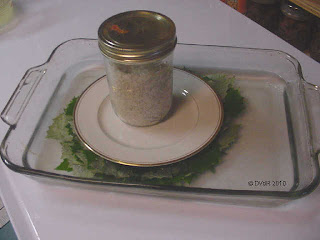Preserved Grape Leaves are expensive to purchase, and I have a grape vine... so I decided to try my hand at fermenting some at home, for a dolmades recipe.
The fermenting recipe is easy. (I'll post the dolmades recipe when I make them.)
Wash the leaves well. I found the leaves repel water under the faucet, so I put them (individually) down flat in a 9 x 12 baking dish of water, where I could run my fingers over both sides, reducing the surface tension, then they gave up more specks rather than just under running water.
Place your stack of leaves in a solution of 1 tablespoon sea salt, 4 tablespoons whey (mine was from draining yogurt to make yogurt 'cheese') in 16 ounces (2 cups) filtered, non-chlorinated water. If you don't have any whey (please don't use packaged whey), double the salt. Salted water encourages the lactobacillus present on the grape leaf skins to begin the ferment, and keeps the pathogens at bay. (The whey has live lactobacillus in it which jump-starts the fermentation.) Fully submerge the flat leaves in a dish for an hour or so, with a weight on top to keep them submerged. Pour the brine solution over them. This helps soften the leaves for rolling. If you don't have enough brine, just make more. I had to double the amount of brine solution for the size of my soaking pan.
After about an hour, stack a few leaves (I used 6), cut the stems off, and roll them into a tube shape. The leaves will roll better with the pale underside of the leaves on the inside. Repeat with remaining leaves. Place tubes in a wide-mouth quart jar and cover with the brine you had them soaking in, making more brine if necessary. I ended up using a half-gallon jar because the leaves I picked were just a bit too wide when rolled to fit in a quart jar. I won't make that mistake again! (Besides, the younger, smaller leaves are more tender.)
Place a lid and ring on the jar and store on the counter at room temperature for 3 or so days. Be sure all the leaves are fully submerged. You should open the jar every 24 hours to smell it, and to let any fermenting gases escape. After several days (maybe 5-7) you can place the jar in a cool, dark place (40-50ºF is ideal) or the refrigerator to continue fermenting, although the cold refrigerator will really slow down the fermentation. At warmer storage temps (but cooler than room temps) they should be ready in a couple of weeks. In fermenting anything, your own taste preference is important. Longer fermentation translates to tangier flavor. This happens more quickly in warm temperatures than in cool ones. If you start a ferment at harvest time, in the autumn, as temperatures are dropping, it can ferment for six months or longer. When you first begin fermenting, taste at maybe a week, and again at 3 more days, and again at 3 more days... and so on... until you get an idea how tangy you like your ferments. Be sure to note how long something fermented to a taste you like, but be sure to be aware not all vegetables will ferment at the same speed.
Results:
Day 1, contents bubbling slowly, leaves taking on a 'cooked' color. Need a weight to keep top edges of leaves submerged. Used the glass top of an old small sugar bowl, inverted. Just fits, with slight room for juice to come up and over it...
Day 2, jar bubbling slowly, but spilling over a little. Contents multi-colored, smells fine.
Day 3, bubbling slowed.
Day 4, no noticable bubbling. Smells fine. Tightened lid and stored in bottom of closet.
ps, I also started a pint of sugar snaps fermenting, just out of curiosity to see what happens. I used half a tablespoon kosher salt and 4 tablespoons whey added to the snaps and topped with water. Within 4 hours they had built up a bit of pressure inside the lid, so obviously they are 'working'.



so basically fermenting is to preserve food from your harvest until you have food growing the next season. Last year I made pickles out of cucmbers and jalapenos but I stuck them in the pressure cooker in a vinegar/brine solution. I did the same with the marinara that I made with the tomatoes.
ReplyDeletecan you ferment a marinara from tomatoes? Or would you just ferment whole tomatoes in salt water? So long as you ensure the vegetables stay covered in brine you don't have to worry about any bad microbes or bacteria?
There are salsas you can ferment, but I haven't seen a recipe for marinara sauce. (Doesn't mean you cannot, though!) I do have several recipes that have tomatoes and I'll be fermenting some when mine ripen. More research has shown me the safest way is using a Fido Jar, and I have carrot medallions with fresh ginger in one and a carrot 'slaw' in another. Look for them to be posted with safety tips in a week or so... I'm out of town right now. The absolute biggest benefit is the nutrients and not cooked away, and some are even added by the lactobacillus as the food ferments.
ReplyDelete